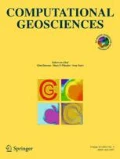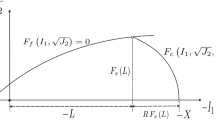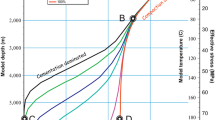Abstract
Reservoir depletion results in rock failure, wellbore instability, hydrocarbon production loss, oil sand production, and ground surface subsidence. Specifically, the compaction of carbonate reservoirs with soft rocks often induces large plastic deformation due to rock pore collapse. On the other hand, following the compaction of reservoirs and failure of rock formations, the porosity and permeability of formations will, in general, decrease. These bring a challenge for reservoir simulations because of high nonlinearity of coupled geomechanics and fluid flow fields. In this work, we present a fully implicit, fully coupled, and fully consistent finite element formulation for coupled geomechanics and fluid flow problems with finite deformation and nonlinear flow models. The Pelessone smooth cap plasticity model, an important material model to capture rock compaction behavior and a challenging material model for implicit numerical formulations, is incorporated in the proposed formulation. Furthermore, a stress-dependent permeability model is taken into account in the formulation. A co-rotational framework is adopted for finite deformation, and an implicit material integrator for cap plasticity models is consistently derived. Furthermore, the coupled field equations are consistently linearized including nonlinear flow models. The physical theories, nonlinear material and flow models, and numerical formulations are the focus of part I of this work. In part II, we verify the proposed numerical framework and demonstrate the performance of our numerical formulation using several numerical examples including a field reservoir with soft rocks undergoing serious compaction.
Similar content being viewed by others
References
Mayuga, M.N.: Geology and development of California’s Giant–Wilmington oil field. In: Geology of Giant Petroleum Fields, American Association of Petroleum Geologists, Memoir, vol 14, pp 158–184 (1970)
Baade, R., Chin, L., Siemers, W.: Forecasting of Ekofisk reservoir compaction and subsidence by numerical simulation. J. Petrol. Technol. 47, 723–728 (1988)
Keszthelyi, D., Dysthe, D.K., Jamtveit, B.: Compaction of North-sea chalk by pore-failure and pressure solution in a producing reservoir. Front. Phys. 4, 1–10 (2016)
Bruno, M.: Subsidence-induced well failure. SPE Drill. Eng. 7, 148–152 (1992)
Vudovich, A., Chin, L.Y., Morgan, D.R.: Casing deformation in Ekofisk. J. Petrol Technol. 41, 729–734 (1989)
Hansen, K., Prats, M., Chan, C.: Modeling of reservoir compaction and surface subsidence at South Belridge. SPE Paper 26074. Presented at SPE Western Regional Meeting, Anchorage, Alaska 26-28 May (1993)
De Rouffignac, E.P., Bondor, P.L., Karanikas, J.M., Hara, S.K.: Subsidence and well failure in the South Belridge diatomite field. SPE Paper 29626. Presented at SPE Western Regional Meeting, Bakersfield, California 8-10 March (1995)
Biot, M.A.: General theory of three dimensional consolidation. J. Appl. Phys. 12, 155–164 (1941)
Rice, J.R., Cleary, M.P.: Some basic stress diffusion solutions for fluid-saturated elastic porous media with compressible constituents. Rev. Geophys. 14, 227–241 (1976)
Coussy, O.: Poromehcanics. Wiley, New York (2004)
Lewis, R.W., Schrefler, B.A.: The finite element method in the static and dynamic deformation and consolidation of porous media, 2nd edn. Wiley, Chichester (1998)
Small, J.C., Booker, J.R., Davis, E.H.: Elasto-plastic consolidation of soils. Int. J. Solids Struct. 12, 431–448 (1976)
Siriwardane, H.J., Desai, C.S.: Two numerical schemes for nonlinear consolidation. Int. J. Numer. Methods Engrg. 17, 405–426 (1981)
Borja, R.I., Alarco, E.: A mathematical framework for finite strain elastoplastic consolidation part 1: balance laws, variational formulation, and linearization. Comput. Methods Appl. Mech. Eng. 122, 145–171 (1995)
Chin, L.Y., Raghavan, R., Thomas, L.K.: Fully-coupled geomechanics and fluid-flow analysis of wells with stress-dependent permeability. SPE J. 5, 32–45 (2000)
Settari, A., Walters, D.A.: Advances in coupled geomechanical and reservoir modeling with applications to reservoir compaction. SPE J. 06, 334–342 (2001)
Douglas, J.: Finite difference methods for two-phase incompressible flow in porous media. SIAM J. Numer. Anal. 20, 681–696 (1981)
Durlofsky, L.J.: A triangle based mixed finite element—finite volume technique for modeling two phase flow through porous media. J. Comput. Phys. 105, 252–266 (1993)
Aziz, K, Settari, A.: Petroleum reservoir simulation. Applied Science Publishers Ltd., London (2007)
Arbogast, T., Dawson, C.N., Keenan, P.T., Wheeler, M.F., Yotov, I.: Enhanced cell-centered finite differences for elliptic equations on general geometry. SIAM J. Sci. Comput. 19, 404–425 (1998)
Wheeler, M.F., Yotov, I.: A multipoint flux mixed finite element method. SIAM J. Numer. Anal. 44, 2082–2106 (2006)
Dean, R.H., Gai, X., Stone, C.M., Minkoff, S.E.: A comparison of techniques for coupling porous flow and geomechanics. SPE J. 11, 132–140 (2006)
Gai, X., Dean, R.H., Wheeler, M.F., Liu, R.: Coupled geomechanical and reservoir modeling on parallel computers. SPE Paper 79700. Presented at SPE Reservoir Simulation Symposium, Houston, Texas 3-5 February (2003)
Mikelic, A., Wang, B., Wheeler, M.F.: Numerical convergence study of iterative coupling for coupled flow and geomechanics. Comput. Geosci. 18, 325–341 (2014)
Kim, J., Tchelepi, H.A., Juanes, R.: Stability, accuracy, and efficiency of sequential methods for coupled flow and geomechanics. SPE J. 16, 249–262 (2011)
Sun, W., Chen, Q., Ostien, J.T.: Modeling the hydro-mechanical responses of strip and circular punch loadings on water-saturated collapsible geomaterials. Acta Geotech. 9, 903–934 (2014)
Pelessone, D.: A modified formulation of the cap model. Technical report No GA-c19579 Gulf Atomics (1989)
Fossum, A.F., Fredrich, J.T.: Cap plasticity models and compactive and dilatant pre-failure deformation. Presented at 4th North American Rock Mechanics Symposium, Seattle, Washington 31 July-3 August (2000)
Foster, C.D., Regueiro, R.A., Fossum, A.F., Borja, R.I.: Implicit numerical integration of a three-invariant, isotropic/kinematic hardening cap plasticity model for geomaterials. Comput. Methods Appl. Mech. Engrg. 194, 5109–5138 (2005)
Motamedi, M.H., Foster, C.D.: An improved implicit numerical integration of a non-associated, three-invariant cap plasticity model with mixed isotropic-kinematic hardening for geomaterials. Int. J. Numer. Anal. Meth. Geomech. 39, 1853–1883 (2015)
Chin, L., Boade, R.R., Prevost, J.H., Landa, G.H.: Numerical simulation of shear-induced compaction in the ekofisk reservoir. Int. J. Rock Mech. Min. Sci. Geomech. Abstr. 30, 1193–1200 (1993)
Ostensen, R.W.: The effect of stress-dependent permeability on gas production and well testing. SPE Form. Eval. 1, 227–235 (1986)
Minkoff, S.E., Stone, C.M., Bryant, S., Peszynska, M., Wheeler, M.F.: Coupled fluid flow and geomechanical deformation modeling. J. Petrol. Sci. Eng. 38, 37–56 (2003)
Yang, Y, Aplin, A.C.: Permeability and petrophysical properties of 30 natural mudstones. J. Geophys. Res. 1-14(2007), 112 (2007)
Gamage, K., Screaton, E., Bekins, B., Aiello, I.: Permeability-porosity relationships of subduction zone sediments. Mar. Geol. 279, 19–36 (2011)
Vairogs, J., Hearn, C.L., Dareing, D.W., Rhoades, V.W.: Effect of rock stress on gas production from low-permeability reservoirs. J. Petrol. Technol. 23, 1161–1167 (1971)
Terzaghi, K.: Theoretical Soil Mechanics. Wiley, New York (1943)
Drucker, D.C., Prager, W.: Soil mechanics and plastic analysis for limit design. Q. Appl. Math. 102, 157–165 (1952)
Sandler, I.S., Dimaggio, F.L., Baladi, G.Y.: Generalized cap model for geological materials. J. Geotech. Engrg. 102, 683–699 (1976)
Simo, J.C., Ju, J.W., Pister, K.S., Taylor, R.L.: Assessment of cap model: consistent return algorithms and rate-dependent extensions. J. Eng. Mech. 1142, 191–218 (1988)
Sandler, I.S., Rubin, D.: An algorithm and a modular subroutine for the cap model. Int. J. Numer. Analyt. Meth. Geomech. 3, 173–186 (1979)
Hofstetter, G., Simo, J.C., Taylor, R.L.: A modified cap model: closest point solution algorithms. Comput. Struc. 462, 203–214 (1993)
Desai, C.S.: Single surface yield and potential function plasticity models: a review. Comput. Geotech. 7, 319–335 (1989)
Desai, C.S., Salami, M.: Constitutive model for rocks. J. Geotech. Engrg. 113, 407–423 (1987)
Lade, P.V., Kim, M.K.: Single hardening constitutive model for frictional materials. Comput. Geotech. 6, 13–29 (1988)
de Boer, R., Dresenkamp, H.T.: Constitutive equations for concrete in failure state. J. Engrg. Mech. 115, 1591–1608 (1989)
Ehlers, W.: A single-surface yield function for geomaterials. Arch. Appl. Mech. 65, 246–259 (1995)
Bigoni, D., Piccolroaz, A.: Yield criteria for quasibrittle and frictional materials. Int. J. Solids Struct. 41, 2855–2878 (2004)
Aubertin, M., Li, L.: A porosity-dependent inelastic criterion for engineering materials. Int. J. Plast. 20, 2179–2208 (2004)
Khoei, A., Azami, A.: A single cone-cap plasticity with an isotropic hardening rule for powder materials. Int. J. Mech. Sci. 47, 94–109 (2005)
Bier, W., Hartmann, S.: A finite strain constitutive model for metal powder compaction using a unique and convex single surface yield function. Eur. J. Mech. A-Solid 25, 1009–1030 (2006)
Lode, W.: Versuche über den Einflußder mittleren Hauptspannung auf das Fließen der Metalle Eisen Kupfer und Nickel. Z. Physik. 913-939, 36 (1926)
Brannon, R.M., Fossum, A.F., Strack, O.E.: Kayenta: Theory and User’s Guide (No. SAND2009-2282). Sandia National Laboratories, Albuquerque (2009)
Stevenson, D.L.: Salem limestone oil and gas production in the Keenville field, Wayne County, Illinois: Illinois State Geological Survey. Department of Registration and Education, Illinois (1978)
Oden, J.T.: Finite Elements of Nonlinear Continua. McGraw-Hill, New York (1972)
Simo, J.C., Hughes, T.J.: Computational Inelasticity. Springer, New York (1998)
Liu, R., Wheeler, M.F., Dawson, C.N., Dean, R.: Modeling of convection-dominated thermoporomechanics problems using incomplete interior penalty Galerkin method. Comput. Methods Appl. Mech. Eng. 198, 912–919 (2009)
Na, S., Sun, W.: Computational thermo-hydro-mechanics for multiphase freezing and thawing porous media in the finite deformation range. Comput. Methods Appl. Mech. Eng. 318, 667– 700 (2017)
Holzapfel, G.A.: Nonlinear Solid Mechanics, a Continuum Approach for Engineering. Wiley, Chichester (2000)
Liu, R., Wheeler, M.F., Yotov, I.: On the spatial formulation of discontinuous Galerkin methods for finite elastoplasticity. Comput. Methods Appl. Mech. Eng. 253, 219–236 (2013)
Schwer, L.E., Murray, Y.D.: A three-invariant smooth cap model with mixed hardening. Int. J. Numer. Analyt. Meth. Geomech. 18, 657–688 (1994)
Swan, C.C., Seo, Y.K.: Limit state analysis of earthen slopes using dual continuum/FEM approaches. Int. J. Numer. Analyt. Meth. Geomech. 23, 1359–1371 (1999)
Xia, K., Masud, A: A new stabilized finite-element method embedded with a cap model for the analysis of granular materials. J. Eng. Mech. 1323, 250–259 (2006)
Author information
Authors and Affiliations
Corresponding author
Rights and permissions
About this article
Cite this article
Liu, Z., Liu, R. A fully implicit and consistent finite element framework for modeling reservoir compaction with large deformation and nonlinear flow model. Part I: theory and formulation. Comput Geosci 22, 623–637 (2018). https://doi.org/10.1007/s10596-017-9715-3
Received:
Accepted:
Published:
Issue Date:
DOI: https://doi.org/10.1007/s10596-017-9715-3




